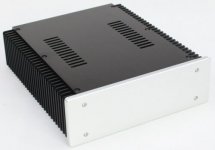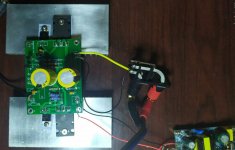same size pcb with side mounting option for slim cases. 18mm dia cap.
5mm to 22.5mm pitch input coupling cap
Nice PCB, as usual! Should work with popular slim cases from eBay (~245x213x70 mm, 60mm internal height). Heatsink might get up to 50-55 C with 30 C ambient.
Attachments
That's exactly the case I want to try the amp in. It houses a gainclone ATM. I wonder about the Rth though, the heatsinks aren't big.
Not comparable to the known mini dissipante or the case for the ACA. The 25K rise is an estimation on your behalf or do you know their Rth?
Not comparable to the known mini dissipante or the case for the ACA. The 25K rise is an estimation on your behalf or do you know their Rth?
Nice PCB, as usual! Should work with popular slim cases from eBay (~245x213x70 mm, 60mm internal height). Heatsink might get up to 50-55 C with 30 C ambient.
I have a feeling that it just might be sufficient for this amp as its all aluminum unlike steel metal boxes...
That's exactly the case I want to try the amp in. It houses a gainclone ATM. I wonder about the Rth though, the heatsinks aren't big.
Not comparable to the known mini dissipante or the case for the ACA. The 25K rise is an estimation on your behalf or do you know their Rth?
Estimated based on the following two heat sinks from HeatsinkUSA.com
8.460" Wide Extruded Aluminum Heatsink - HeatsinkUSA
1.1 C/W per 3" (22 fins)
10.000" Wide Extruded Aluminum Heatsink - HeatsinkUSA
0.9 C/W per 3" (26 fins)
The one on this chassis is approx 9 1/4" wide 2.5" height and 30 fins. I also came across taller versions of this case in AliExpress.
Last edited:
Thanks hanair, that gives me some confidence to try the case. And Prasi has a good point here: some of these cases as this one have substantial front and back plates that can easily be put to good use if you enhance the thermal coupling between them and the heatsinks by gap pads or thermal foil.
The front is 7mm thick and the back at least 3mm.
That could raise the thermally conducting surface by quite a bit.
The front is 7mm thick and the back at least 3mm.
That could raise the thermally conducting surface by quite a bit.
It is going to get really hot for sure! I built a pair of JLH1969, with each side on a heatsink at least double this size. Temperature was upper 50's C while each side was dissipating about 35W.
If you are purchasing new chassis, you can go for taller model with the same width and depth, similar to this:
KYYSLB 211*90*257MM Amplifier Chassis Blank Shell with Cooling on Both Sides DIY Box Enclosure 2109 Amp Amplifier Case House|Amplifier| - AliExpress
If you are purchasing new chassis, you can go for taller model with the same width and depth, similar to this:
KYYSLB 211*90*257MM Amplifier Chassis Blank Shell with Cooling on Both Sides DIY Box Enclosure 2109 Amp Amplifier Case House|Amplifier| - AliExpress
I never ventured into Class-A because of the heat concerns. I am going to do this trial and error and see where it goes!
This is what I am thinking: Irrespective of the amplifier efficiency, the power dissipation on each side is going to be 22W. If we want to keep temperature rise caused by this heat to 25C over the ambience then we need a heat sink that is rated at 25C/22W (~1.14 C/W) or less than ~1.1 C/W. You may have to adjust Iq after an hour or so until it reaches an equilibrium temperature that you are comfortable with and suitable for your surroundings. 55C is pretty hot! This is assuming that the sink temperature of 55C can keep the transistor junction temperature within its limits (which certainly is the case from my estimates even for TO220).
This is what I am thinking: Irrespective of the amplifier efficiency, the power dissipation on each side is going to be 22W. If we want to keep temperature rise caused by this heat to 25C over the ambience then we need a heat sink that is rated at 25C/22W (~1.14 C/W) or less than ~1.1 C/W. You may have to adjust Iq after an hour or so until it reaches an equilibrium temperature that you are comfortable with and suitable for your surroundings. 55C is pretty hot! This is assuming that the sink temperature of 55C can keep the transistor junction temperature within its limits (which certainly is the case from my estimates even for TO220).
Last edited:
My experimental setup is playing music with substitutes! Mounted TIP41C and TIP42C on the heat sink along with TTC5200. Just put together this PCB in KiCAD after several years and it is no way near perfect. Using a cheap SMPS@24V with some added reservoir capacitor for this testing. Power consumption from the wall is ~26W for one channel.
BC547 => 2N4401 NPN small signal
BC557 => 2N4403 PNP small signal
BD139 => TIP41C NPN driver
BD140 => TIP42C PNP driver
Output: TTC5200
BC547 => 2N4401 NPN small signal
BC557 => 2N4403 PNP small signal
BD139 => TIP41C NPN driver
BD140 => TIP42C PNP driver
Output: TTC5200
Attachments
Last edited:
Not an expert but think it should work fine with the TIPs.Can we substitute...
Bias current was a little lower so adjusted R5.
Also had to increase C3 from 47p to 100p as it was oscillating in the simulation.
(Scope at base of U6 for example; ~2.6MHz). Everything referring to original schema at post #4.
Let us know how you like it. In the same boat as you; have been hesitant so far to build something class-A and simply intrigued if I hear a difference.
The circuit can also be scaled up relatively easily if you need 10W or so.
I´ll publish my gerber for anyone who wants them but prefer to have someone test the PCB first. (forwarded the files to two members and awaiting their opinion) I won´t finish mine before autumn due to other projects.
Thanks for doing the simulation! I will check for oscillations and increase C3 to 100pF. What was your R5 to maintain the Iq?
I tried to lower Iq by increasing R5 to keep the heat generation in check, which may not be a good idea because the amplifier just clips once it exceeds the limit. If everything goes fine, this is going to be in my office room that already gets really hot with everything else in it. I haven't decided between this and JLH1969. Both sound really good from my limited testing. My ears are getting old, so you have to take my opinions with a pinch of salt!
I tried to lower Iq by increasing R5 to keep the heat generation in check, which may not be a good idea because the amplifier just clips once it exceeds the limit. If everything goes fine, this is going to be in my office room that already gets really hot with everything else in it. I haven't decided between this and JLH1969. Both sound really good from my limited testing. My ears are getting old, so you have to take my opinions with a pinch of salt!
Last edited:
Can someone please tell me mouser part# for an appropriate fuse holder?my Diy pcb etching version.
Last edited:
Sorry hanair, haven´t seen the question was for me.What was your R5 to maintain the Iq?
I used R5=0.5Ohm in LTSpice to keep an Iq~1.05A @20V in the TIP-version.
Last edited:
Thank you prasi!
The fuse holder itself and the cover are two different parts, am I correct?
yes
- Home
- Amplifiers
- Solid State
- Class A, 4 Watt, No Feedback, Simple Circuit, Great Sound

